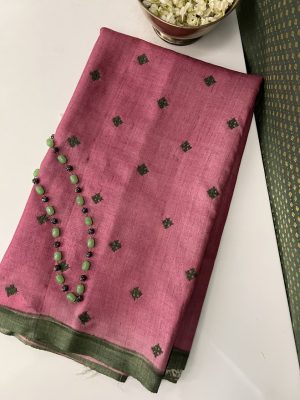Handwoven tussar saree hand dyed in ombre shades of blue on the body, and a hand embroidered kutch work all over the saree in white. The pallu is heavily worked and stands out. The saree also has mukaish work all over and adds a little bit of bling to the saree. The blouse is plain blue with hand embroidered kutch border
- New Arrivals
- Rang
- Sarees
ADDITIONAL SERVICES
- Ready-To-Wear
- Collections
- Blouses
CRAFT
- Men’s Wear
CRAFT
- Accessories
- Yardages
- Zero Waste
- FAQ
- New Arrivals
- Rang
- Sarees
ADDITIONAL SERVICES
- Ready-To-Wear
- Collections
- Blouses
CRAFT
- Men’s Wear
CRAFT
- Accessories
- Yardages
- Zero Waste
- FAQ
- New Arrivals
- Rang
- Sarees
ADDITIONAL SERVICES
- Ready-To-Wear
- Collections
- Blouses
CRAFT
- Men’s Wear
CRAFT
- Accessories
- Yardages
- Zero Waste
- FAQ

Tushara ombre blue
₹15,500.00
Out of stock
Out of stock
Embroidery care
Embroidery work on fabrics is much prized. At Aavaranaa, we have our own karigars who do hand-embroidery and machine work too. For a majority of our projects we work on hand-embroidery. Learn how to care for them.
# Embroidery work like aari and zardosi may involve metal wires, beads and sequins to be used. We recommend you do not machine wash such fabrics. Avoid exposure to perfumes and harsh chemicals and dry clean them.
# We also incorporate kutch & kantha work embroidery with mirrors. Kutch and kantha work embroidery is best dry cleaned.
# For machine embroidery which only involves thread, it is safe to wash in gentle cycle in the machine. However we recommend dry cleaning them for the first wash
Care Instructions
Silk is made from the cocoon of silk worms. India has a rich heritage of silk weaving. Apart from Mulberry silk, India is known for producing tussar, muga and ahimsa silks. Some of these are wild and some of these are farmed commercially. Each of these silks has its own property when it comes to sheen, shine and wear. Being a natural fabric, silk does shed, wear and tear with age. However, caring for them ensures they have a long life. Silk Care & Wash # We recommend air drying silks after every use. Silks do not require washing after every wear unless soiled. # We recommend giving our sarees for dry cleaning for the first few washes. # Silk sarees can be washed at home using a gentle detergent or soap nuts. Avoid soaking & scrubbing these fabrics. Any stains should be dry cleaned. # Avoid tumble dry and instead line dry away from direct sunlight. # Silk sarees should be regularly worn to avoid fraying. If kept in humid or dry spaces for long without wear, silks are likely to deteriorate. So wear your sarees well. # If you are unable to wear them regularly, remove them and change folds from time to time. We do not recommend hanging them. If stacked, ensure there isn’t too much weight on the sarees. # Avoid using naphthalene balls or other chemicals while storing silks. Heavy silks may be stores in muslin bags. # If you can, roll them on wooden rods to store them wrinkle free. However, gentle folding works well too.











Tushara ombre blue
₹15,500.00
Out of stock
Out of stock

Handwoven tussar saree hand dyed in ombre shades of blue on the body, and a hand embroidered kutch work all over the saree in white. The pallu is heavily worked and stands out. The saree also has mukaish work all over and adds a little bit of bling to the saree. The blouse is plain blue with hand embroidered kutch border
Embroidery care
Embroidery work on fabrics is much prized. At Aavaranaa, we have our own karigars who do hand-embroidery and machine work too. For a majority of our projects we work on hand-embroidery. Learn how to care for them.
# Embroidery work like aari and zardosi may involve metal wires, beads and sequins to be used. We recommend you do not machine wash such fabrics. Avoid exposure to perfumes and harsh chemicals and dry clean them.
# We also incorporate kutch & kantha work embroidery with mirrors. Kutch and kantha work embroidery is best dry cleaned.
# For machine embroidery which only involves thread, it is safe to wash in gentle cycle in the machine. However we recommend dry cleaning them for the first wash
Care Instructions
Silk is made from the cocoon of silk worms. India has a rich heritage of silk weaving. Apart from Mulberry silk, India is known for producing tussar, muga and ahimsa silks. Some of these are wild and some of these are farmed commercially. Each of these silks has its own property when it comes to sheen, shine and wear. Being a natural fabric, silk does shed, wear and tear with age. However, caring for them ensures they have a long life. Silk Care & Wash # We recommend air drying silks after every use. Silks do not require washing after every wear unless soiled. # We recommend giving our sarees for dry cleaning for the first few washes. # Silk sarees can be washed at home using a gentle detergent or soap nuts. Avoid soaking & scrubbing these fabrics. Any stains should be dry cleaned. # Avoid tumble dry and instead line dry away from direct sunlight. # Silk sarees should be regularly worn to avoid fraying. If kept in humid or dry spaces for long without wear, silks are likely to deteriorate. So wear your sarees well. # If you are unable to wear them regularly, remove them and change folds from time to time. We do not recommend hanging them. If stacked, ensure there isn’t too much weight on the sarees. # Avoid using naphthalene balls or other chemicals while storing silks. Heavy silks may be stores in muslin bags. # If you can, roll them on wooden rods to store them wrinkle free. However, gentle folding works well too.
Recently Viewed
Related Products
People who viewed this also viewed...
Naavya blush pink
This product is currently out of stock and unavailable.

Mayur – Forest green carnation saree
Mayur – Forest green carnation saree
₹15,200.00



